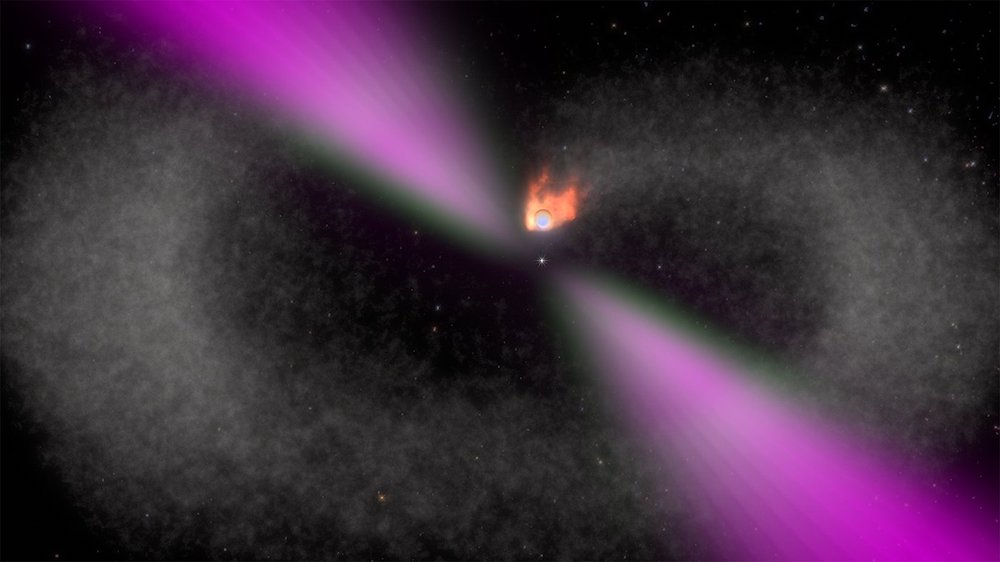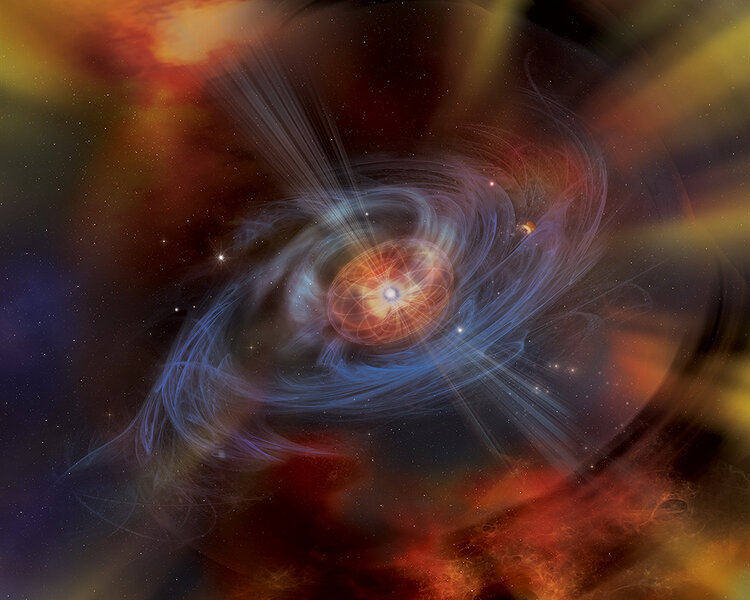Black widow pulsar is eating its companion in an hour-long dance
The name is creepy, but certainly apt.

Astronomers have discovered a new example of a creepy kind of dead star that shoots death rays so powerful they cook their binary companion star and eat its remains.
No, I’m not kidding. And this discovery is interesting because the two stars are closer together than any other object in its class, swinging around each other in an astonishing 62 minutes. This makes it a weird example of what’s a weird class of objects in the first place.
To look for such objects, a team of astronomers used archived observations from the Zwicky Transient Facility — a sky survey that takes huge images of the sky every night — looking for things that move or change brightness: Asteroids, supernovae, variable stars, black holes with bad table manners, and the like.
They searched the data for short-timescale periodic brightness changes in 20 million objects that were fainter than you’d expect for a star of their kind. That may seem pretty specific, but then they had a specific kind of object in mind: black widow pulsars.
That’s an apt name for something that, well, shoots out a death ray, cooks its companion, and eats it.
I’ve written about pulsars many times:
Pulsars are neutron stars, the incredibly dense corpse of the core of a massive star that exploded as a supernova. The outer layers of the star get blasted away, but the core itself collapses. If the core has less than about three times the Sun’s mass it will become a ball of neutrons very roughly 20 kilometers wide. This makes it ultradense; a cubic centimeter of it — the size of a six-sided die — will have a mass of about 100 million tons, about the same as if you took every car in the United States and crushed them down until all together they were the size of a sugar cube.
Neutron stars tend to spin rapidly, and have powerful magnetic fields that can be trillions of times stronger than Earth’s. This sets up a lot of different phenomena; one is that this powers incredibly strong beams of radiation that blast away from the magnetic poles of the star, which sweep around the sky due to the neutron star’s rotation like a pair of lighthouse beams. When these beams pass over Earth we see a blip of light, a pulse, hence the term pulsar.
Some pulsars are solitary, and others have “normal” stars like the Sun orbiting them. It’s not a lot of fun being near a pulsar, but if you’re a star far enough away you can survive, even in a binary system.
But some stars are much closer in and face the fury of hell.
A star that close is more likely to be hit by those spinning beams of radiation, and also the beams’ effects on them are more powerful. They can zap the binary companion star so energetically that it heats up and loses material — the pulsar is almost literally boiling it away. That material then leaves the star and flies into space… where some will fall onto the pulsar, feeding the energy and the beams.
Again, black widow pulsar is amazingly apt.
So that’s what the astronomers were looking for in the data, and not only did they find one, they found a weird one. Called ZTF J1406+1222, it’s about 3,700 light-years away from us and has the shortest orbital period of any known black widow, just 62 minutes. That means the two objects are very close together; for a standard neutron star mass of 1.4 times the mass of the Sun, the companion has a mass just a twentieth of the Sun’s — so about 50 times Jupiter’s — and their orbit is only about 800,000 km across. That’s less than three times the distance of the Moon from the Earth.
That secondary object is getting fried.
That’s already strange, but it gets stranger. The mass of the second object is too small to be a normal star. It’s possibly a brown dwarf, an object more than about 13 but less than about 77 times the mass of Jupiter. It might also be a star that was once like the Sun but lost a lot of mass to the pulsar, exposing its core. Whatever it is, its density is 10 grams per cubic centimeter, which is high. Twice as dense as Earth, and 10 times that of a normal star. On the low end for a brown dwarf, but again also possibly an old, mostly eaten stellar core.
The amount of energy the pulsar beams is staggering, about 10 times the Sun’s total energy output. The astronomers calculated the temperature of the secondary object, and found that on the side facing away from the pulsar beams it’s about 6,300° C, but on the side facing into the beams it’s over 10,000°C. Ouch. Those beams are heating it up by about 4,000° C, and likely that heat from the dayside carries over into the night side via circulation in the atmosphere. Interestingly that’s hotter than many stars, so if that secondary is a brown dwarf it’s a whole lot different than other ones, which are generally pretty cool temperature-wise. And if it’s a stripped core that would be amazing to know as well.
There’s a third star too; the astronomers measured the motion of the pulsar through space and found another star traveling with it. If that actually is a second companion in what is then a trinary system, it’s pretty far removed, with the third star taking very roughly 10,000 years or so to orbit once. That’s a long way off, but still, what a view!
If you could survive it. I think I prefer seeing it from Earth. Still, the third star, if it is physically associated, will help astronomers understand this system, because somehow it stayed bound to the binary even at such a distance. A supernova is an exceedingly violent event; being able to keep a third star makes the physics tricky.
Everything about this object is tricky. I imagine astronomers will be looking to get more data on it because it’s full of surprises, and it’ll be a fun puzzle to solve. And that’s one of the biggest reasons we observe the skies.





























